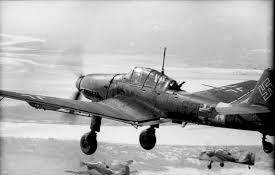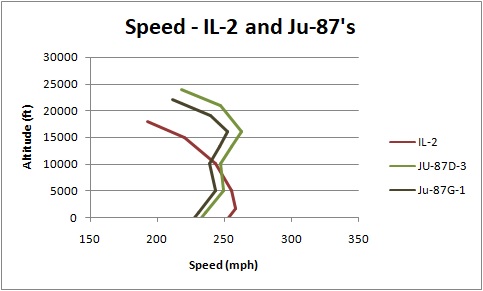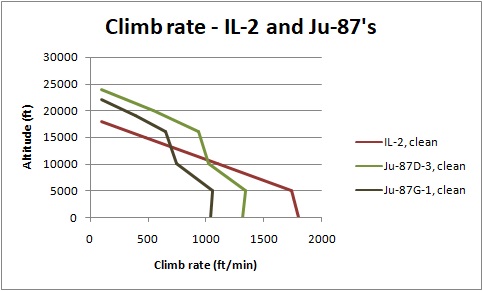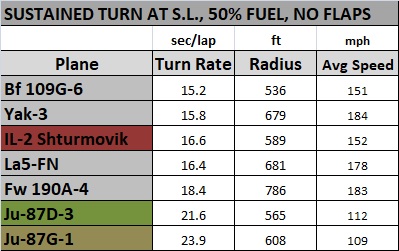

Released Mar 2019
---== UPDATE FL2067: TANK BUSTERS OF THE EASTERN FRONT ==---
By: Robert, Grumpy, Bollok, Jabo and Sleepy.
All made possible by: Bcamel (creator of the program used to model the airplanes), and Idunno (who has shared a vast amount of aerodynamical knowledge).
--= Ilyushin IL-2 Shturmovik =--
Full rehaul of the IL-2 dive bomber flightmodel. See further down for details.
--= Junkers Ju-87 Stuka series =--
Full rehaul of the Ju-87D-3 and Ju-87G-1 dive bomber flightmodels. See further down for details.
--= Messerschmitt Bf 109 series =--
The elevator heaviness with increasing airspeed has been found to be slightly to severely set. The Bf 109G should be able to pull around 5.5 G's at 310 mph IAS, but could currently only pull 4.5 G's at this speed. This is an issue for all Bf 109's. As such the elevator is now set to increase slightly less in heaviness so that Bf 109's can now pull ~5.5 G's at 310 mph IAS as they should. The elevator will still be nearly inoperable at to high speeds, but at 400 mph IAS one will now be able to pull ~0.7 G's extra.
---== THE ILYUSHIN IL-2 SHTURMOVIK FULL REHAUL ==---
One of the most iconic Russian airplanes of ww2 was probably the IL-2 Shturmovik, often called "The flying infantryman". It was the most numerously built plane of Russia and was a specialized dive bomber, fielding the powerful Mikulin AM-38F engine which provided 1720 hp at sea level. It was very poor at high altitudes though and the IL-2 had a service ceiling of only 18000 ft (5500 m). The Shturmovik's whole center fuselage structure was made of armor, and the armor covered both the fuselage, engine and pilot, ranging between 5-12 mm thickness. The pilot was also protected by a 65 mm armored windshield. There were several occasions of German fighter pilots reporting their bullets bouncing of the Shturmovik. The German veteran pilots learnt to attack the IL-2 from down and under, destroying it by hitting the hydraulics system of the belly. Against ground targets only 20 mm cannons really posed a threat to the IL-2, and enemy fighters attacking from behind was a far greater concern. While the pilot was well protected, the rear gunner was more easily killed by enemy fire and the tail section was made of wood and more susceptible to damage. Often times rear gunners were recruited from the Gulag death-camp prisons. Roughly 10750 IL-2's were lost in action during 1941-1945. The Ilyushin IL-2 was on many occasions used in air-to-air to attack German bombers and Stukas. It was effective as a Stuka-killer since the defensive machine gun of the Ju-87 had trouble penetrating the thick armor of the IL-2 and the Shturmovik had a better power-to-weight ratio than the Ju-87 at low altitudes, allowing it to outturn the German dive bomber when down low. The job it was made for though was to support the Russian ground troops by attacking artillery positions and German tanks. The Russian accounts of German tanks destroyed by the IL-2 in battles were often greatly exaggerated, but the Shturmovik definitely made an important difference in the war and was the demise of many German tank crews.
---== THE JUNKERS JU-87 STUKA SERIES FULL REHAUL ==---
The Junkers Stuka dive bombers spread terror in the opening stages of ww2 by attacking ground targets with it's dive sirens screaming and easily recognisable inverted gull wings. It was a very sturdily built plane able to sustain a high G-load and was generally quite easy to handle at all speeds. As long as it had fighter escort the Stuka was very good at it's job. In the Battle of Britain though the Ju-87B's were often unescorted and fell prey to the British fighters, taking heavy losses when intercepted. The Ju-87D-3 that fought over the Eastern front was more heavily armored than previous versions and had the new Jumo 211-J engine, allowing for 1240 hp at 5000 ft, and with a short duration take off power of 1410 hp. It could also carry a much higher payload of 1800 kg (3968 lb) at overload conditions. At the Eastern front the Ju-87's often had escort and were very effective at killing tanks and other ground targets. Stukas even sunk several Russian battleships and cruisers. They racked up ground-kills for very few losses and the most decorated pilot of Germany was a Stuka pilot, Hans-Ulrich Rudel, accounted with the destruction of 519 Russian tanks and sinking the "Marat" battleship. As the tide of the war turned though Germany soon had a harder time providing adequate fighter escort for the Stukas, and their losses started to amount when faced alone against Russian fighters. The Ju-87's still kept busting many tanks, but now at a much higher cost. The Stukas have a very gentle stall behaviour, and are decently agile and can defend themselves as long as they have energy and altitude to sacrifice. They have a much better high altitude performance compared to the IL-2 Shturmovik. Once low n' slow though their low power-to-weight ratio means that they'll have a very hard time turn fighting and maneuvering. A positive trait is that the Ju-87D's/G's are well armored and can withstand more damage from the front than a normal fighter would.
--= The Ju-87D-3 =--
This version had upgraded armor and could carry a very high payload for a single engine plane. In overload conditions it could be armed with a single 1800 kg bomb or 1x 1000 kg bomb under the fuselage and 2x 250 lb bombs under the wings. It could also use drop tanks for long range missions. The climb rate in overload condition though is only 1.5-2.5 m/s (300-500 ft/min), but the extra payload can be well worth it once at the target.
--= The Ju-87G-1 =--
A development of the D-3, the Ju-87G-1 used two heavy 37 mm BK cannons with 12 rpg instead of bombs. This version fielded the same Jumo 211-J engine as the D-3, and was a very effective can opener against Russian armored ground vehicles. In clean configuration the G-1 was heavier than the D-3 and the cannons caused more drag, affecting the top speed.




<S>
/Robert